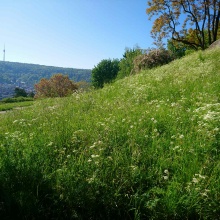Grasslands are widespread elements of urban greenspace providing recreational, psychological and aesthetic benefits to city residents. Two urban grassland types of contrasting management dominate urban greenspaces: frequently mown, species-poor short-cut lawns and less intensively managed, near-natural tall-grass meadows. The higher conservation value of tall-grass meadows makes management interventions such as converting short-cut lawns into tall-grass meadows a promising tool for urban biodiversity conservation. The societal success of such interventions, however, depends on identifying the values urban residents assign to different types of urban grasslands, and how these values translate to attitudes towards greenspace management. The results of our study show that a plurality of values assigned to different types of urban grasslands should be considered in urban greenspace planning. For example, tall-grass meadows could be managed to accommodate the values associated with short-cut lawns, such as tidiness and recreation potential, to support their societal acceptance.


